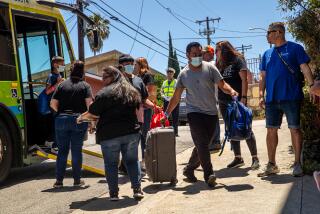Around the World in 20 Days : Aviation: Small planes embark to commemorate 68th anniversary of first circumnavigation.
- Share via
Last year, Calabasas attorney Norman Schwartz climbed to the bottom of Mt. Everest, the farthest his 55-year-old legs would take him.
Hoping for better luck, Schwartz embarked Saturday from Santa Monica Airport on another demanding feat: flying around the world in a caravan of small planes in honor of the first pilots to circumnavigate the globe 68 years ago.
The First Annual Around the World Air Rally is scheduled to take 20 days, far less than the 5 months and 22 days it took the Donald Douglas World Cruiser biplanes that left Santa Monica on April 6, 1924.
Back then, only two of the four planes made it back. The other two were forced down in Alaska and over the North Atlantic, but the pilots survived.
“Obviously, it’s not as risky because we have better equipment and maps, but whether you go around the world in a small plane in 1924 or in 1992, the spirit remains the same,” said Schwartz. “To circle the world in your own plane--it can’t get much better than that.”
Fifteen pilots from five countries paid $50,000 to $80,000 per plane to take part in the rally, which was organized by Eric Vercesi, 32, a Studio City resident and owner of a local aviation export company.
Vercesi said the purpose of the trip is twofold: to realize an aviator’s dream of flying around the world and to improve communications with Russia. The planes are carrying letters from schoolchildren in Europe and the United States, including the private Curtis School in Los Angeles, to youngsters in the former Soviet Union.
Although organizers of the 1924 flight chose to leave Santa Monica in early spring, the modern group chose July in the hopes of encountering the best weather possible along the 17,000-mile route through five countries in the Northern Hemisphere.
The flights differ in other aspects.
Sixty-eight years ago, when the Army commissioned Donald Douglas to build the World Cruiser, the plane averaged about 75 m.p.h., said Bob Convey, manager of operations for the Museum of Flying in Santa Monica, where one of the two historic planes is on display.
The single- and twin-engine aircraft that left Santa Monica on Saturday fly at speeds at least twice that, Vercesi said.
The modern-day pilots plan to fly about eight hours daily, making 17 stops. In contrast, the 1924 aviators stopped countless times to make repairs, Convey said.
Nonetheless, the group is likely to encounter turbulence over the Atlantic and freezing temperatures in Siberia, organizers said. Yet the pilots who gathered at the airport for a preflight breakfast Saturday were remarkably sanguine.
Dr. Howard Wisner, an orthopedic surgeon from Dallas who owns 12 planes and has flown around the world three times, said the biggest obstacle he has encountered are officious airport personnel. Therefore, Wisner eschewed the tan flight suits worn by the other pilots in the rally and donned a light blue shirt with epaulets and captain’s bars that resemble those worn by commercial airline pilots.
“I’d do anything it takes to be up there in my plane watching the entire world unfold,” he said. “It’s just an incredible view.”
More to Read
Sign up for The Wild
We’ll help you find the best places to hike, bike and run, as well as the perfect silent spots for meditation and yoga.
You may occasionally receive promotional content from the Los Angeles Times.






